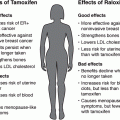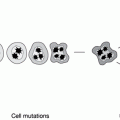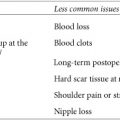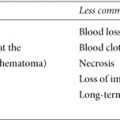Chapter 18
Diagnosis
Hereditary Cancer
JUST TWO GENERATIONS AGO, cancers were rarely discovered until they were well advanced, almost always with dismal outcome. There is still much we don’t know, but treatment is becoming more sophisticated, more personalized, and much more successful. Discovering that all cancers aren’t the same has expanded our arsenal of postdiagnosis tools. Although facing cancer is never easy, treatments are less invasive, less toxic, and more tolerable.
For most women with breast cancer, the disease is discovered early and is no longer a death sentence. In the United States, over 2.5 million breast cancer survivors attest to improved methods of prevention, detection, and treatment. Although screening for ovarian cancer remains unreliable, we’re finding more early stage tumors when women have prophylactic surgery. And even though most ovarian cancers are advanced by the time symptoms develop, newer, less toxic treatments allow women to live longer with fewer side effects and better quality of life.
How Important Is a Second Opinion?
It’s always wise to get a second opinion about diagnosis and treatment; most insurance plans cover the cost. Gather your medical records and find a specialist by contacting your local American Cancer Society or the NCI’s Cancer Information Service (www.cancer.gov/help, or 800-4-CANCER). In almost all cases, briefly delaying treatment to get another opinion isn’t a problem. Let your doctor know you’d like a second opinion and ask when your treatment must begin.
Treating Hereditary Cancers
Chemotherapy
For many women, chemotherapy is the most frightening aspect of cancer. The thought of being fatigued and nauseated, losing your hair, and having your life generally disrupted isn’t pleasant. Dealing with side effects may require additional treatment—medications can curb nausea, stabilize white cell count, and help to maintain your strength. Yet chemotherapy saves lives. Newer therapies target mainly cancer cells and have fewer undesirable effects, leaving healthy cells to perform their normal functions. Neoadjuvant (before surgery) chemotherapy is often used to shrink a large tumor so that surgery doesn’t need to be as extensive. Adjuvant (after surgery) treatment targets remaining cancer cells.
Two tests improve the traditional trial-and-error approach to breast cancer chemotherapy, helping doctors determine which early stage cancers will most likely recur and will therefore benefit from chemo treatments—an example of how treatment is becoming more personalized. Using a sample of tumor tissue from your lumpectomy or mastectomy, OncoType DX examines twenty-one different genes and is recommended for stage 1 ER/PR+ invasive breast cancers. The MammaPrint test works similarly for tumors smaller than five centimeters—that’s half of all breast cancer diagnoses—and assesses seventy genes that influence tumor progression in ER/PR+ and ER/PR– tumors. (These prognostic tests look only at gene changes that have occurred in the tumor. They aren’t the same as testing for inherited BRCA mutations that are present in all the body’s cells.) If you have invasive breast cancer, ask your oncologist during your preliminary consultation if you meet guidelines for either test before you decide on a course of treatment. Some health insurers may pay for a portion or all of either test. If you’re uninsured or can’t afford the full cost, contact the test manufacturers (www.agendia.com and www.oncotypedx.com) about their financial assistance programs.
Platinum drugs are chemotherapies frequently used for ovarian cancer and less often for breast cancer. They weaken or destroy malignant cells by interfering with their ability to repair DNA damage. Cisplatin and carboplatin are particularly effective against ovarian cancers. Although they’re not generally used as first-line treatment in breast cancer, some research suggests that platinum drugs may be particularly effective against cancers in people with BRCA mutations. In a small trial, nine of ten women with BRCA1 mutations who were treated with neoadjuvant cisplatin for stage 1 to stage 3 breast cancers had a pathologically complete response—their tumors shrank until they were no longer visible.1
PARP Inhibitors
A new class of targeted drugs called PARP inhibitors holds promise for BRCA-related cancers. These medications block poly (ADP-ribose) polymerase proteins, substances used by cells to repair DNA damage. They appear to be especially effective at preventing cancer cells from repairing themselves once they’re damaged by chemotherapy, with less effect on healthy cells—a great advantage over traditional chemotherapy, which indiscriminately targets all rapidly growing cells. This selective targeting means fewer side effects and quicker recovery.
PARPis performed well in three clinical trials. They benefited women with metastasized triple-negative breast cancer, a common type of breast cancer among African American women and women with BRCA1 mutations. Individuals who took PARPis intravenously along with chemo had improved responses—the drugs slowed progression of their cancers and the women lived longer—compared to those who received chemotherapy alone.2 Two of the studies involved women with BRCA mutations whose metastatic breast cancer or recurrent ovarian cancer had progressed after previous chemotherapy. Both groups benefited from PARP inhibitors taken orally without chemotherapy, compared to women who had chemotherapy alone.3 The drugs were effective and well tolerated whether participants had mutations in BRCA1 or in BRCA2, and most side effects were mild. Not all participants with BRCA mutations and advanced cancer responded this way.
Early research of PARPis for prostate and pancreatic cancer is also promising. These studies are exciting, but more large-scale research is needed to determine whether PARP inhibitors prevent return of early stage cancers and slow progression of advanced cancers. If successful, these medications might become an entirely new way of treating inherited cancers and will likely be combined with chemotherapy treatment. Even with favorable trials, it could take years before they’re available outside clinical trials.
Stay updated, free articles. Join our Telegram channel

Full access? Get Clinical Tree







